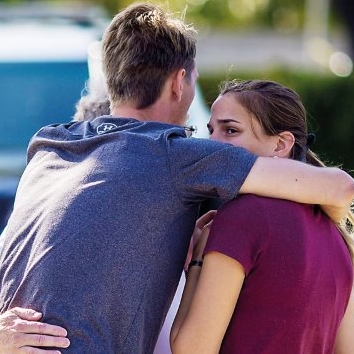click to dowload our latest edition
CLICK HERE TO SUBSCRIBE TO OUR NEWSLETTER


Published
5 years agoon
By
adminANDREW SILOW-CARROLL
What we didn’t know: why he targeted a synagogue; why he wanted Jews to die; what combination of personal madness and outside influences drove him to murder and terror.
What we don’t hesitate to do in the absence of hard information: draw our own conclusions; lay blame; wedge the shooter’s scant bio into the political frameworks that we’ve already erected.
The “react” story has long been a staple of ethnic journalism. After a big global or national event, you round up the reactions of, in our case, Jewish organisations. Rarely are these condemnations or celebrations surprising or even very interesting. Sympathy at natural calamities, outrage at man-made ones, thumbs up or thumbs down when the story is political, depending on your ideology.
As to anti-Semitism reactions, how many ways can an organisation express its dismay at acts of anti-Jewish hatred, except to go to the thesaurus? They’re a “scourge”, a “disease”, a “poison”, a “pathology”.
But that formula has changed, like just about everything else, certainly in the past three years, and perhaps over a decade and more.
Jews can no longer agree on how to regard anti-Semitism. The left focuses on a far right energised by the rise of nationalist populism and politicians whose own nativist views sound awfully familiar to historians of hate. The right sees anti-Israelism as the “new anti-Semitism”, and regards as the biggest threat those whose support for the Palestinians quickly devolves into classic anti-Jewish “tropes”. Centrists are criticised for trying to straddle the line because failing to take sides means they are weak on [insert your enemy here].
The dynamic was on display in the hours after the shooting at the Poway Chabad. The Anti-Defamation League (ADL), long the community’s compass on anti-anti-Semitism, avoided the blame game.
“It’s heartbreaking to see yet another tragedy on Shabbat, on the last day of Passover, exactly six months after the shooting at the Tree of Life synagogue in Pittsburgh,” which claimed 11 lives, the ADL wrote on Saturday.
But the ADL also didn’t look to include the Poway shooting into some sort of grab bag of anti-Jewish threats on the left and the right, which has become the safe way to talk about anti-Semitism. Instead it compared the shooting only to the recent attacks carried out by white, male lone wolves – Christchurch, Pittsburgh – and to the far-right hate fest at Charlottesville.
Others saw in Poway a reflection of their worst fears and bêtes noires. For a left-wing group like Bend the Arc: Jewish Action, the blame lay squarely on the White House and its current occupant.
“Although it may be hard to accept, the fact that we witnessed yet another act of white nationalist violence is sadly not ‘hard to believe’, as President Trump said in response to the shooting,” Bend the Arc said. “Not when the President and his allies have helped mainstream white nationalism in American politics.”
Compare that to the Friends of the Simon Wiesenthal Center for Holocaust Studies, a Canadian affiliate of the Los Angeles-based Simon Wiesenthal Center.
The Friends group was fast out of the gate with a statement saying that, “anti-Semitism and hate at large continues to increase year to year as nationalist white supremacist groups expand globally”, but expanded the camera view to include “extreme leftists [who] unfairly and hypocritically defame Israel and radical Islamists [who] push an anti-Zionist agenda”.
It also included in its statement a condemnation of what normally would have been the most outrageous anti-Semitic act of 28 April 2019: a cartoon that appeared in the New York Times international edition depicting Israeli Prime Minister Benjamin Netanyahu as a guide dog (a guide dachshund, actually), leading a blind Trump. The dog’s collar has a Star of David, and Trump is wearing a black yarmulke, pushing the cartoon out of the realm of political commentary and into Der Sturmer territory.
Unlike Bend the Arc, however, the Friends of the Wiesenthal Center statement did not point fingers at the American president or mention the actual Nazis who marched at Charlottesville or ran as Republicans in last year’s midterms. Instead it condemned college students and professors who support the boycott of Israel, and leftist political leaders like the British Labour Party’s Jeremy Corbyn and Republican Ilhan Omar, “who have been accused of promoting anti-Semitism and of trying to create a wedge between their countries and the State of Israel”. It also singled out the United Nations for its “baffling” anti-Israel resolutions.
There was still another approach, which was to find the commonalities among the various brands of contemporary anti-Semitism.
“The anti-Semitic intersection of white nationalism, anti-Zionism, and Islamic Jew-hatred is to render the Jews isolated and powerless,” tweeted Einat Wilf, who served in the Israeli Knesset as a member of the Labor and Independence parties. “Each feeds off the others as evidence that Jews have no allies, and therefore could be bullied, maligned, injured, and killed, with no consequences.”
Unsurprisingly, this common cause approach is rarely the way of Twitter, where the left-right divide is often on full display. Either modern anti-Semitism is Trump’s fault, or the Boycott Israel movement is the greatest danger facing the Jews. That New York Times cartoon was the result of vicious anti-Zionism gone mainstream or part of the coarsening of the public discourse led by the “alt-right”.
For many there appears to be a fear that if the focus turns to one side of the political spectrum, we’ll go soft on the anti-Semitism coming from the other side.
The historian Deborah Lipstadt notes this politicisation of anti-anti-Semitism in her new book, Antisemitism: Here and Now.
“Don’t see anti-Semitism only on the other side of the political transom from which you are located,” she warned in an interview with the Jewish Telegraphic Agency. “If you’re only seeing it on the opposite side of the transom, you’re instrumentalising this for political purposes.”
